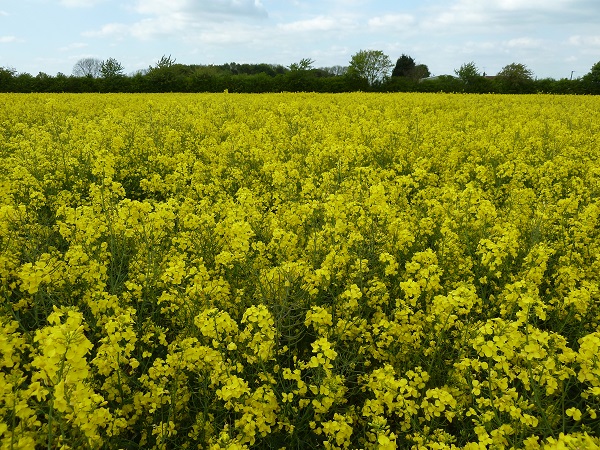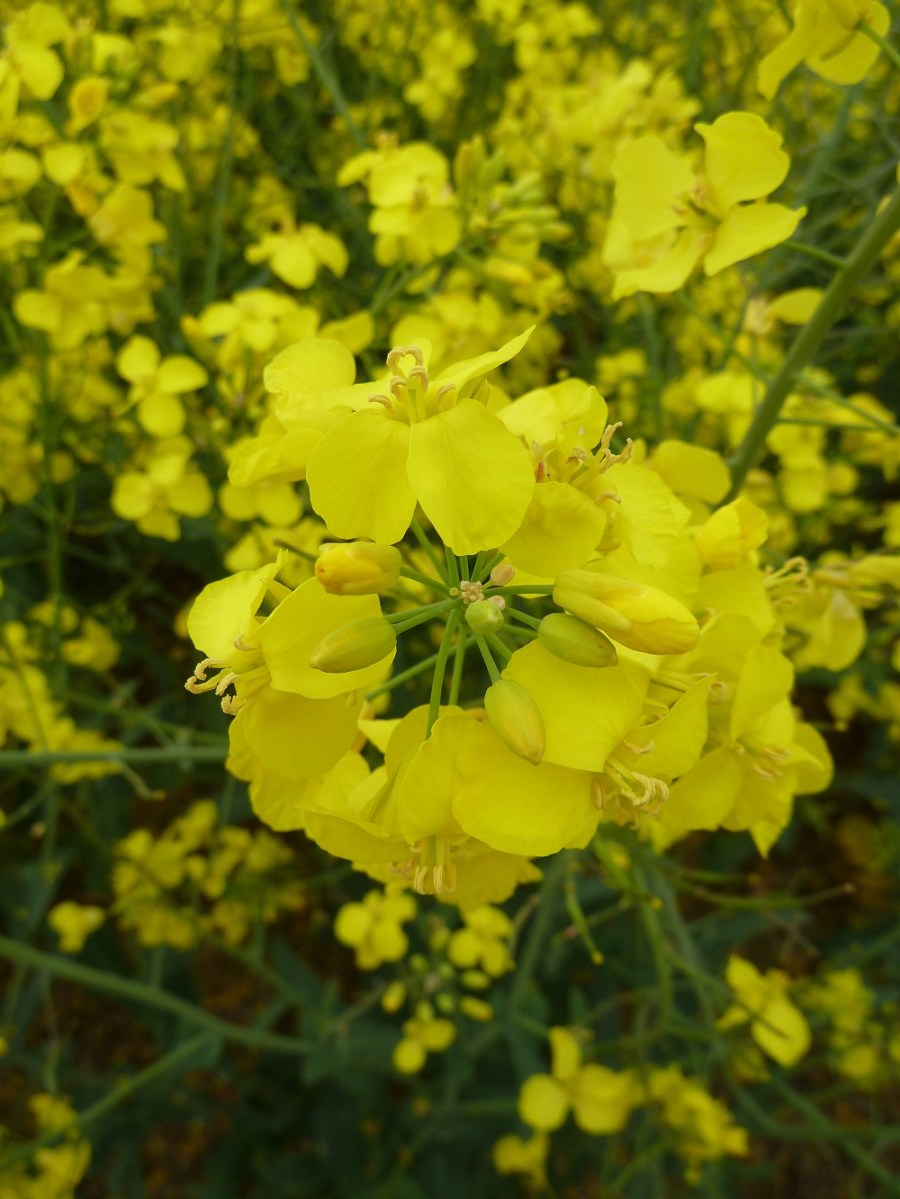Turnip Yellows Virus, the invisible yield robber, has a new foe named Architect, Limagrain’s latest TuYV-resistant oilseed rape variety. Boasting a high yield and gross output, it’s likely to turn heads.
Sometimes when looking at varieties, there’s not a lot to say, but with Architect, there’s a lot to talk about.
By Melanie Jenkins
Sitting comfortably on the AHDB Candidate List, Architect immediately stands out from the crowd based on its resistance to Turnip Yellows Virus (TuYV) alone – but this variety offers so much more than that. A high-yielding hybrid oilseed rape, with a gross output at 105% of the control, Architect is leaps and bounds ahead of its predecessor, Amalie.
“Architect is the first hybrid Limagrain has launched with TuYV resistance,” explains Vasilis Gegas, senior OSR breeder at Limagrain. It has done very well in 11 other European countries such as Germany, France, Poland and the Czech Republic, he says, which is indicative of the resilience and the adaptability of the variety, particularly as OSR doesn’t usually travel well between countries.
“I believe it’s done well in such diverse environments because of its unique package of agronomic characteristics,” he adds. The virus resistance means Architect can still reach its genetic yield potential under high levels of infection and outperform non-resistant varieties.
“Architect is very exciting – I expect it to get approved for recommendation,” says David Leaper at Agrii. “There’s no significant yield difference between any of the hybrid candidates on the AHDB Recommended List but this could offer up to 8% additional yield in instances of TuYV infections – the virus is often symptomless but erodes yield and frequently gets overlooked as a disease.”

Architect has a gross output of 105 and disease scores of 6 for LLS and phoma.
Richard Torr at Wynnstay agrees that Architect is a variety worth taking note of and is likely a safe bet for recommendation. “I am genuinely quite excited – it has an awful lot going for it. The TuYV resistance is a very useful trait, and the fact that it’s available in a high-yielding hybrid makes us very interested,” he says. “Sometimes when looking at varieties, there’s not a lot to say, but with Architect, there’s a lot to talk about.”
In years where aphids are numerous and widespread in the autumn, TuYV can infect crops across the country, and even using an application of aphicide is unlikely to stop the spread of infection. “In 2015, there was a high incidence of infection in the UK, to the extent that nearly every sample had it,” explains David Leaper.
“TuYV can often go unnoticed. It can cause interveinal yellowing of the lower and middle leaves often with some purpling but frequently it may be symptomless,” adds David Leaper. After the ban on neonicotinoids, aphid control has been severely reduced, so having a variety which is resistant to the virus they spread could make a big difference.
“Neonicotinoids would control aphids but there’s less protection now, particularly as aphids have become more resistant to pyrethroids,” he explains. It means Architect could potentially save growers money spent on autumn aphicides and insecticides, he adds.
David Leaper visited a trial field of untreated OSR in the Cotswolds near the end of April and noted that the leaf health of Architect was really good and green, whereas adjacent trial plots were looking stressed and red with symptoms that concur with the presence of TuYV.
However, some farmers may be put off after growing the conventional variety, Amalie, and finding the viral resistance was of little to no advantage due to its overall gross output, compared to higher yielding varieties. “Amalie didn’t get a foothold in the market because of its low yield,” explains David Leaper.
This is where Architect really stands out as it has a gross output that can compete with the top varieties. “Now that the TuYV resistance is in a higher yielding variety, it’s pretty exciting. It doesn’t want to be tarred with the same brush as Amalie as it’s a very different animal.”
Richard Torr agrees that Amalie may have put some growers off, but suggests they weigh up the benefits and potential downsides. “Growers would quite like a variety with virus resistance, but still need strong agronomics and don’t expect to have a step back in yield – which is why we’re so excited about Architect – it’s a bit of a no brainer.”
Its disease scores are perfectly adequate, coming in at 6 for light leaf spot and 6 for phoma stem canker, but it’s yet to be seen how the variety fares in an environment with verticillium wilt, explains David Leaper.
On top of this, Architect also has pod-shatter resistance bred into it, which gives growers flexibility and the opportunity to mitigate risks, explains Vasilis Gegas. “It has one of the best levels of resistance to pod shatter in Limagrain’s tests, where we precisely measure the force required for the pods to open.”
Pod-shatter resistance also gives growers an advantage during harvest, he adds. “Without resistance, the harvest window can be narrow, between four to five days. But with it, this can extend up to 14 days or longer.” In addition, resistance also reduces the number of volunteers in the following crops.
In Agrii trials, Architect has proved to be particularly fast in its speed of autumn development, coming in second only to Bayer’s InVigor 1035 for vigour. “Architect has similar characteristics to varieties like DK Extrovert and a fast growth habit,” says David Leaper.
Though this isn’t a growth habit that would usually appeal to French and German growers, this variety is especially winter hardy and alongside the TuYV resistance, this makes it just as appealing for growers on the Continent as those in the UK, he adds. “It’s also good if farmers have issues with pigeons or slugs.”
Richard Torr has also received feedback from growers that Architect establishes quickly, and is similar to Incentive is this respect. “In both autumn and spring growth, it appears to be a vigorous type.”
Scoring 6.4 for maturity on the AHDB list, it’s on the earlier side, which is exactly where Limagrain wants it to be, says Vasilis Gegas.
It’s relatively early flowering and maturing – both characteristics that suit an OSR grower, as will the pod shatter resistance, adds David Leaper. “It’s a real thumbs-up for this variety as it’s going to have a broad appeal for growers.”
Architect has stiff straw, and is as stiff as conventional varieties, says Vasilis Gegas. “This helps mitigate yet another risk, especially in locations prone to tall crops.”
However, Richard Torr is slightly concerned that it could be on the tall side. “In an ideal world, it would be a touch smaller, but then, it’s not much taller than other varieties on the RL.”
Architect will fit in across all geographical locations and soil types in the UK, according to David Leaper. TuYV infections depend on the autumn weather and the migration of aphids, and has been found up in Scotland, not just in the South West and more brassica-dominant regions. “In Scotland, the fast development of Architect will be practical as the window of establishment is quite small.”
Although Architect sets a new bar for performance, it’s likely to be the headliner of a cavalry of new varieties, offering growers a wide selection of attractive traits. It’s the first variety to be produced from Limagrain’s UK precision breeding programme, explains Vasilis Gegas. “Working on specific traits at the beginning, we can more or less predict the outcome.”
Limagrain operates a four-tiered breeding system, starting with the discovery and innovation stage, which involves collaboration with a wide number of institutions. The second stage uses molecular and genetic tools to select the particular traits desired, which then leads to the development of hybrids. The third stage involves breeding under UK conditions to enhance the yield potential and stability, while the fourth stage is the continual assessment of market requirements.
“This way we can deliver what the farm needs as we start right at the beginning in the UK,” explains Vasilis Gegas “The ‘breeding in the UK for the UK’ principle is central to our efforts to tailor solutions to the challenges that OSR growers face in this country.”
Limagrain has a host of trait-specific varieties in the pipeline and is using the same approach as with Architect to create clubroot-resistant hybrid varieties, Clearfield hybrids and HOLL varieties, with traits such as TuYV and pod-shatter resistance incorporated into them.
“We’re aiming to have certain traits as standard, so farmers get cutting edge genetics,” says Vasilis Gegas. “We’ve only been able to do this because of the precision-breeding approach. It also means we spend more time screening material to adapt to conditions, rather than screening for traits.”
Limagrain is also looking at verticillium wilt and sclerotinia resistance, with the aim of bringing something new to the market. “The target is to produce varieties with the right combination of traits to suit the UK requirements,” he adds. “Given the difficult situation with OSR, we aim to provide the best possible solutions. We’re not only building yield potential but also protecting the yield potential in the variety and therefore reducing the year-to-year yield fluctuation, which is so common on commercial farms.”
Richard Torr agrees that Architect’s traits offer assurance to growers seeking less variation in yield. With very limited options for chemical control of aphids, genetic resistance gives more reliable protection from the day the crop is sown. He expects it to take a reasonable market share but suggests that it may take another year to really settle into the market.
According to Vasilis Gegas, there’s plenty of Architect available this year. “We expect it to claim a good chunk of the market, not only because of its TuYV resistance, but also because it offers a complete package that fits the bill for many farmers.”
Virus worries prompt Architect appeal
Alfie Mallinder, farm manager for A. J. Harris and Son, has 12ha of Architect in the ground near Armthorpe, Doncaster. Working very closely with his agronomist, Richard Seels, at Hutchinsons, the decision was made to try the variety as last year’s OSR crop suffered a lot of TuYV due to some of the farm being on black land – in wet autumns it can be difficult to get on the fields to spray for aphids.
The farm grows winter wheat, spring wheat, sugar beet and winter and spring OSR. It’s mainly planted with spring crops as it’s situated on light sandy soils that run into black land and there are issues with manganese deficiency.
The plot of Architect was drilled on 22 Sept 2016 on a rich soil type, behind a crop of wheat. The field was ploughed and power harrowed before the Architect was planted using a Kuhn Venta Combiliner combination drill.
Architect established nicely and took off very quickly, explains Richard Seels. “In the winter, it did very well and had very little disease in terms of LLS and phoma, but this has been symptomatic of the season.”
The seed came with a fungicide seed treatment on it and the crop was then sprayed for flea beetle on 5 Oct, with an application of AstroKerb (aminopyralid+ propyzamide) on 21 Nov and trace elements on 21 Apr, but had no P and K because these appeared high in the soil analysis. It had 160kgN/ha in the form of bagged ammonium nitrate which was applied on 11 Apr in one go.
There has been no evidence of TuYV this year and Alfie Mallinder’s gut feeling is that Architect will outperform varieties that have suffered from TuYV and should yield on par to other OSR varieties he grows – subject to some rain. “The target is for 4t/ha and whatever oil content we get will be a bonus. The crop is now in full flower and looks set to do well; if it yields well, we would grow it again.”
Architect at a glance





